Easy Chicken Alfredo Recipe (4 Steps to Creamy Perfection)
The Enduring Appeal of Chicken Alfredo Few dishes evoke such universal comfort and indulgence as Chicken Alfredo. The mere mention of its name conjures images of silky pasta, tender chicken, and a sauce so rich and creamy it feels like a culinary hug. Far from its humble origins, this dish has evolved into a global favorite,…
The Enduring Appeal of Chicken Alfredo
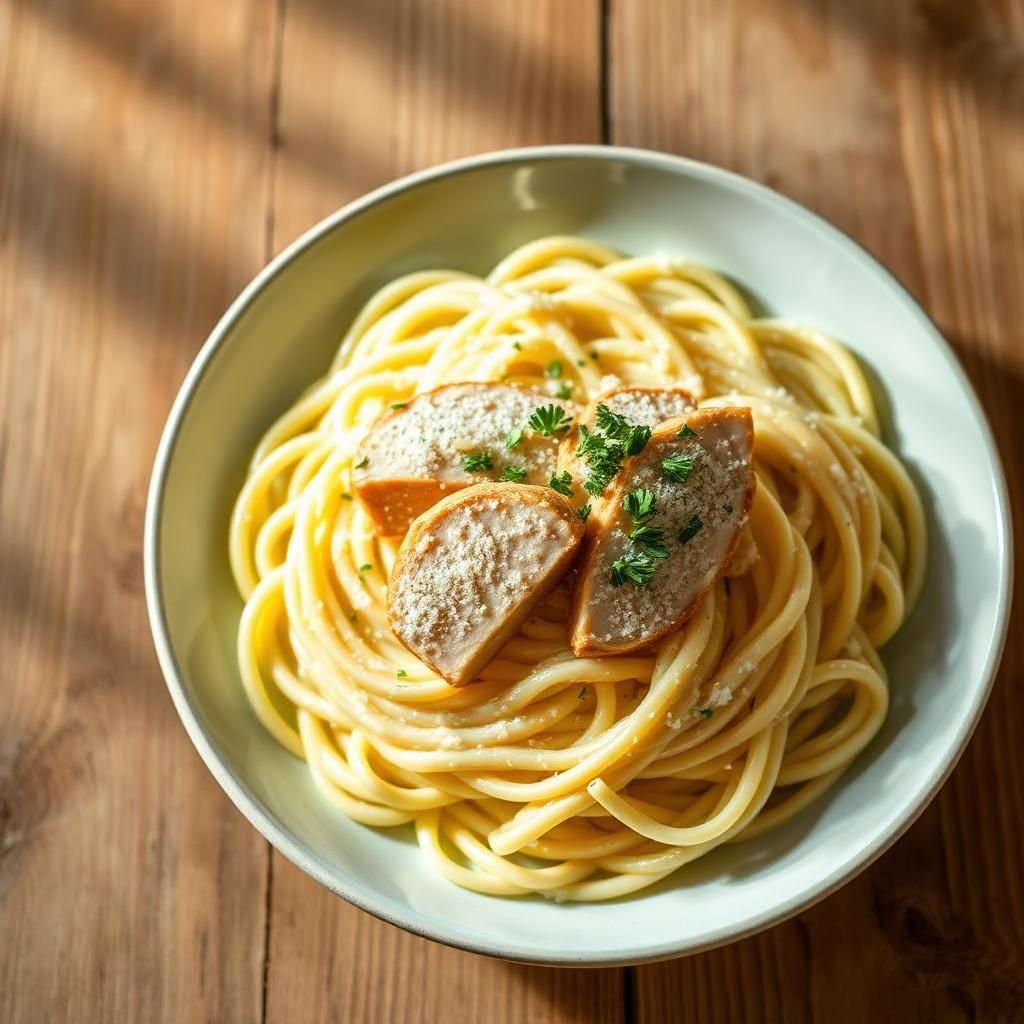
Few dishes evoke such universal comfort and indulgence as Chicken Alfredo. The mere mention of its name conjures images of silky pasta, tender chicken, and a sauce so rich and creamy it feels like a culinary hug. Far from its humble origins, this dish has evolved into a global favorite, gracing tables in homes and restaurants alike. But what exactly is Alfredo, and how can you recreate that perfect, restaurant-quality Chicken Alfredo recipe in your own kitchen?
Alfredo is, at its heart, a creamy, dreamy pan sauce made primarily from rich butter and finely grated Parmigiano-Reggiano cheese. While some traditionalists might debate additions, in our ultimate Chicken Alfredo recipe, we champion the use of heavy cream to achieve that consistently luscious, dreamy, and stable texture that Americans have come to adore. Unlike béchamel — another classic French mother sauce — Alfredo is best made and enjoyed immediately, as its delicate emulsion can separate if left to cool and reheat improperly. However, with our expert tips, even leftovers of this Chicken Alfredo recipe can be a delight.
You can use this versatile Alfredo sauce for coating nearly anything, from vibrant roasted vegetables like broccoli or asparagus, to various proteins. Yet, its most iconic pairing remains with fettuccine pasta, creating the timeless Fettuccine Alfredo. Here, we’re taking that classic a step further, presenting a comprehensive Chicken Alfredo recipe that combines tender, perfectly cooked pasta with succulent, golden-crisp chicken breast. This creates a deeply satisfying and elegant dinner that holds the power to transform even the most regular weeknight into a special culinary occasion. Get ready to impress yourself and your loved ones with this incredible Chicken Alfredo recipe that promises both ease and gourmet quality.
The Fascinating Journey of Alfredo: From Rome to American Comfort
To truly appreciate our Chicken Alfredo recipe, it’s worth understanding the storied journey of Alfredo sauce itself. The original Fettuccine Alfredo, born in Rome, Italy, at the restaurant “Alfredo alla Scrofa” (now “Alfredo alla Scrofa”), was a surprisingly simple dish. Created by Alfredo di Lelio in the early 20th century to help his wife regain strength after childbirth, it consisted of just three ingredients: fresh fettuccine, abundant butter, and a generous amount of freshly grated Parmigiano-Reggiano cheese.
The magic was in the mantecatura – the skillful tossing of the pasta with butter and cheese, using a bit of starchy pasta water to emulsify into a rich, creamy sauce without any cream at all. This pure, light, yet incredibly flavorful sauce was meant to be eaten immediately.
When American celebrities like Mary Pickford and Douglas Fairbanks visited Alfredo’s restaurant in the 1920s, they fell in love with the dish and brought the Chicken Alfredo recipe‘s fame (and a gold fork and spoon gift) back to the United States. However, adapting to American tastes and ingredient availability, the recipe evolved. Heavy cream was introduced to make the sauce more stable, richer, and easier to scale for restaurant production.
This Americanized version, often featuring garlic and even various proteins like chicken or shrimp, became the ubiquitous “Alfredo” we know and love today. Our Chicken Alfredo recipe embraces this delicious American interpretation, perfecting the creamy, dreamy version that has become a comfort food staple.
The Science of Supreme Creaminess: Why This Chicken Alfredo Recipe Works
Understanding the “why” behind certain cooking techniques elevates your culinary skills. For our Chicken Alfredo recipe, the science of emulsion and flavor building is key:
- Emulsion is Everything: The core of Alfredo’s appeal is its smooth, creamy texture. An emulsion is a mixture of two liquids that normally don’t mix, like oil and water. In classic Italian Alfredo, the fat from the butter and the starch from the pasta water, combined with the protein in the cheese, emulsify to create the sauce. In our heavy cream version of this Chicken Alfredo recipe, the cream (which is already an emulsion of fat in water) provides a stable base, making it easier to achieve that velvety consistency.
- Butter’s Role: Butter not only provides rich flavor but also contains milk solids and water, which contribute to the sauce’s texture when heated and combined with other liquids. European-style butter, with its higher fat content, delivers an even richer mouthfeel.
- Parmigiano-Reggiano’s Magic: Freshly grated Parmigiano-Reggiano is crucial. Its high protein content acts as an emulsifier, binding with the fats and liquids to create a smooth sauce. Pre-grated cheese often contains anti-caking agents (like cellulose) that prevent it from melting smoothly, leading to a gritty or clumpy sauce – a major pitfall for any Chicken Alfredo recipe.
- The Power of Pasta Water: This unsung hero is the secret weapon in many Italian pasta dishes, and vital for our Chicken Alfredo recipe. The starchy water left after boiling pasta helps to emulsify the sauce, allowing the fats (from butter and cream) and liquids to blend seamlessly with the cheese. It also adds a subtle saltiness and helps the sauce cling perfectly to the pasta.
- Searing for Flavor (Maillard Reaction): When you sear the chicken breasts for this Chicken Alfredo recipe, you’re creating the Maillard reaction – a complex chemical process that browns the surface of the chicken, developing hundreds of new flavor compounds. These browned bits (fond) left in the pan become the flavor foundation for your Alfredo sauce, adding incredible depth that plain butter and cream alone cannot achieve. This is a critical step for a truly flavorful Chicken Alfredo.
By understanding these principles, you’ll not only master this Chicken Alfredo recipe but also gain insights that improve all your cooking endeavors.
Key Ingredients for the Best Chicken Alfredo
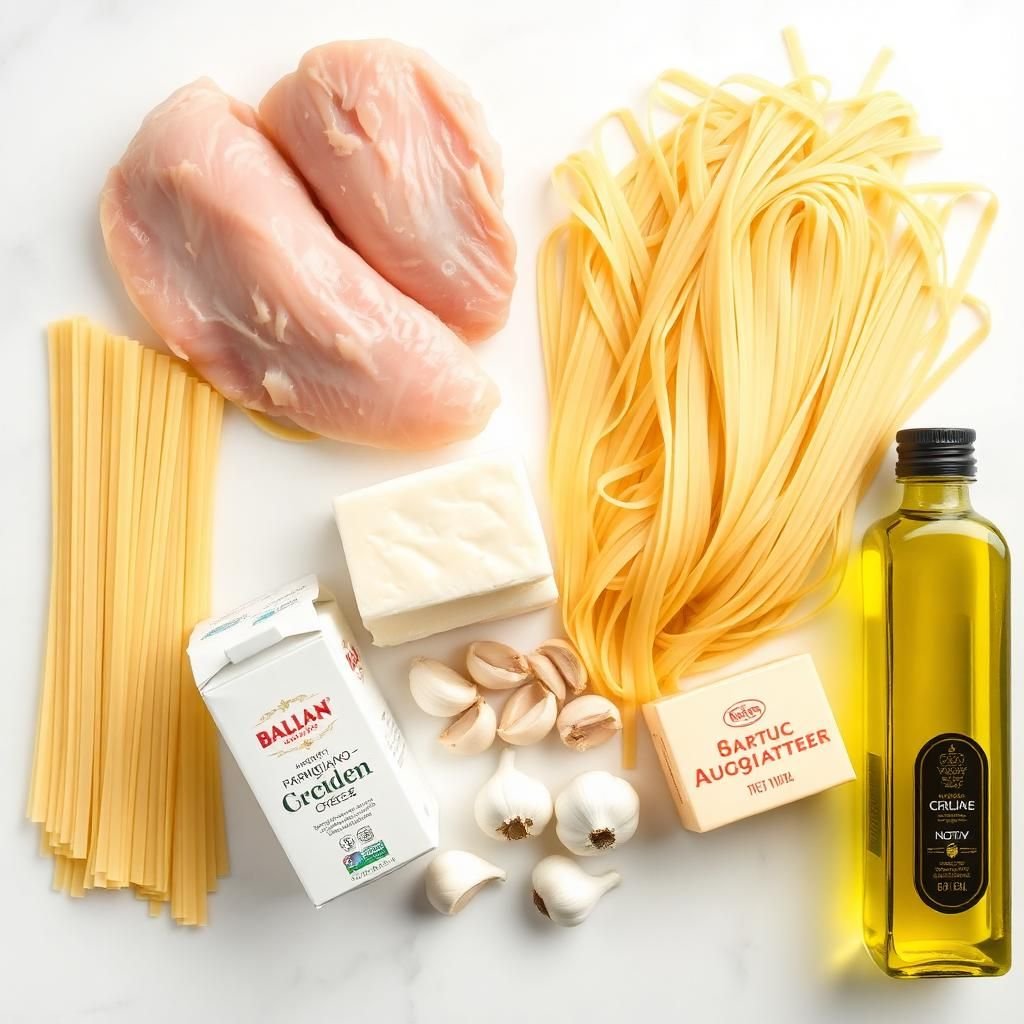
To make this truly the best Chicken Alfredo recipe, selecting high-quality ingredients is paramount. Each component plays a vital role in achieving that sought-after creamy, rich, and flavorful dish.
- Fettuccine (and other Pasta Shapes):
- Quantity: This Chicken Alfredo recipe calls for a generous half pound of pasta, which is ideal for serving four people. This ensures a good pasta-to-sauce ratio.
- Classic Choice: Fettuccine, with its wide, flat surface, is the most classic choice for Alfredo as it provides ample surface area for the rich sauce to cling to, ensuring every bite is coated in creamy goodness.
- Alternatives: Don’t limit yourself! While fettuccine is traditional, this Chicken Alfredo recipe is incredibly adaptable. You can use other long noodles like linguine, spaghetti, or tagliatelle. Short noodles such as penne, rigatoni, or even cavatappi also work wonderfully, trapping the sauce within their nooks and crannies. The key is to choose a good quality pasta that holds up well to a rich sauce.
- Heavy Cream:
- Why it’s Crucial (for this version): While the original Roman Alfredo does not use cream, our Chicken Alfredo recipe (the Americanized, incredibly popular version) relies on heavy cream for its luscious body and stability. Heavy cream, with its high fat content (typically 36% or more), creates a robust emulsion that resists breaking and provides that decadent, velvety mouthfeel everyone loves.
- Avoid Substitutions: Do not substitute with half-and-half, milk, or evaporated milk. These lower-fat alternatives are much more prone to curdling when heated, especially with the addition of cheese, and simply won’t achieve the desired richness and consistency for a top-tier Chicken Alfredo recipe.
- Chicken Breasts:
- Cut: Boneless, skinless chicken breasts are the standard for this Chicken Alfredo recipe due to their lean profile and quick cooking time.
- Preparation: Pounding the chicken breasts to an even thickness (about 1/2 to 3/4 inch) is crucial. This ensures they cook evenly and quickly, preventing dry spots and ensuring tender, juicy results.
- Flavor Boost: Searing the chicken in a skillet before making the sauce is a critical step. The browned bits (fond) left on the bottom of the pan from the chicken will infuse the sauce with incredible depth of flavor, making your Chicken Alfredo recipe far more savory than if you were to cook the chicken separately or use pre-cooked chicken.
- Unsalted Butter (European-Style Recommended):
- Why Unsalted? Using unsalted butter gives you precise control over the overall saltiness of your Chicken Alfredo recipe. Both the pasta water and Parmigiano-Reggiano contribute salt, so starting with unsalted butter prevents the dish from becoming overly salty.
- European-Style: European-style butter typically has a slightly higher fat content and lower water content compared to American butter. This higher fat content contributes to an even creamier, richer, and silkier sauce, enhancing the luxurious feel of your Chicken Alfredo. If unavailable, high-quality regular unsalted butter will still yield fantastic results.
- Parmigiano-Reggiano Cheese (Freshly Grated is Non-Negotiable):
- The King of Cheeses: True Parmigiano-Reggiano from Italy is essential. It offers a complex, nutty, salty, and umami flavor that no other cheese can replicate.
- Freshly Grated: This is perhaps the single most important tip for a successful Chicken Alfredo recipe. Pre-grated or pre-shredded parmesan (often labeled “Parmesan cheese”) usually contains anti-caking agents like cellulose. These agents prevent the cheese from melting smoothly, resulting in a gritty, clumpy, or oily sauce rather than a silky, emulsified one. Always buy a block and grate it yourself immediately before adding it to the sauce.
- Garlic:
- Form: Fresh garlic, minced finely, provides the best aromatic foundation for the sauce. While garlic powder can be used in a pinch, it lacks the fresh, pungent depth that minced cloves provide to this Chicken Alfredo recipe.
- Quantity: Typically, 2-3 cloves are sufficient, but adjust to your personal preference for garlic intensity.
- Salt and Freshly Ground Black Pepper:
- Salt: Essential for seasoning both the pasta water and the sauce. Remember to taste and adjust!
- Pepper: Freshly ground black pepper adds a delightful aromatic bite and visual appeal.
- Nutmeg (Optional, but Recommended):
- A Secret Ingredient: A tiny pinch of freshly grated nutmeg is a classic addition to cream sauces in Italian cuisine. It’s subtle but enhances the richness of the cream and cheese, adding a whisper of warmth without tasting overtly like nutmeg. It’s a professional touch for your Chicken Alfredo recipe.
- Olive Oil: Used alongside butter for cooking the chicken. Olive oil has a higher smoke point than butter, preventing the butter from burning during the searing process, while still allowing the butter to contribute its flavor.
Essential Equipment for Your Chicken Alfredo Recipe
Having the right tools can make the cooking process smoother and more enjoyable. For this Chicken Alfredo recipe, you’ll need:
- Large Pot (4-6 Quart): For boiling the pasta. A larger pot allows the pasta enough room to move freely, preventing sticking and ensuring even cooking.
- Large Skillet (10-12 Inch, preferably cast iron or stainless steel): Crucial for searing the chicken and building the Alfredo sauce. The larger surface area allows for proper searing of the chicken, and a good quality skillet will help create those flavorful browned bits (fond) that are essential for the sauce.
- Tongs: Indispensable for handling pasta and chicken, and for tossing the finished dish.
- Whisk: Essential for emulsifying the Alfredo sauce and ensuring it’s perfectly smooth and lump-free.
- Microplane Grater or Box Grater: For freshly grating the Parmigiano-Reggiano cheese. A microplane produces fine, fluffy shreds that melt seamlessly into the sauce.
- Cutting Board & Sharp Knife: For prepping the chicken and garlic.
- Meat Mallet (Optional, but Recommended): For pounding the chicken breasts to an even thickness. If you don’t have one, the side of a heavy pan or a rolling pin can work.
- Measuring Cups & Spoons: For accurate ingredient quantities.
- Colander: For draining the pasta.
- Heatproof Liquid Measuring Cup: For reserving pasta water.
4 Basic Steps for Making Perfect Chicken Alfredo Pasta
This detailed, step-by-step guide will walk you through creating an unforgettable Chicken Alfredo recipe. While it involves two pans, the timing is designed for efficiency, allowing you to bring everything together seamlessly.
Step 1: Prepare Your Ingredients and Start the Pasta Water
- Chicken Preparation: Begin by preparing your chicken breasts. If they are thick, place each chicken breast between two sheets of plastic wrap or in a large resealable bag. Using a meat mallet or the bottom of a heavy skillet, pound them to an even thickness of about 1/2 to 3/4 inch. This ensures quick and even cooking. Pat the chicken dry thoroughly with paper towels – this is crucial for achieving a beautiful golden crust when searing. Season both sides generously with salt and freshly ground black pepper.
- Garlic & Cheese: Mince your garlic cloves finely. Grate your Parmigiano-Reggiano cheese using a microplane or the fine side of a box grater. Remember, freshly grated cheese is paramount for a smooth sauce.
- Pasta Water on the Boil: Fill your large pot with water (about 4-5 quarts for 1/2 pound of pasta). Add a generous amount of salt – it should taste like the sea (at least 1-2 tablespoons). Place the pot over high heat and bring it to a rolling boil.
Step 2: Cook the Chicken Breasts
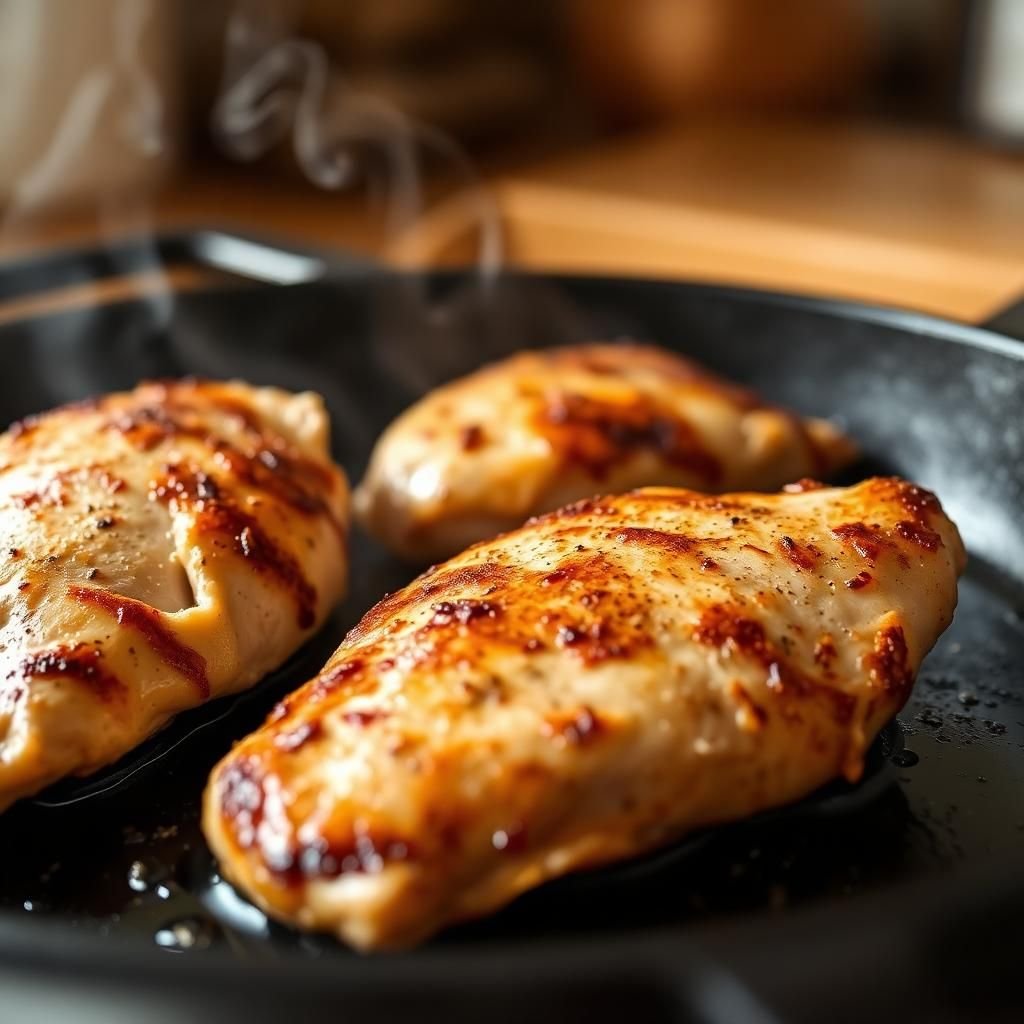
- Heat the Skillet: While the pasta water is heating, place your large skillet over medium-high heat. Add 1 tablespoon of olive oil and 1 tablespoon of unsalted butter. Let the butter melt and become foamy, but don’t let it brown excessively.
- Sear the Chicken: Carefully place the prepared chicken breasts into the hot skillet. Do not overcrowd the pan; cook in batches if necessary. Sear for 4-6 minutes per side, or until the chicken is golden brown, crispy, and cooked through (internal temperature reaches 165°F / 74°C). The beautiful golden crust is not just for appearance; it’s packed with flavor.
- Rest the Chicken: Once cooked, transfer the chicken breasts to a cutting board. Cover them loosely with aluminum foil to keep them warm and allow the juices to redistribute. This step is essential for tender, juicy chicken in your Chicken Alfredo recipe.
- Cook the Pasta: By now, your pasta water should be boiling. Add the fettuccine to the boiling water and cook according to package directions until al dente. This means it should be firm to the bite, not mushy.
- Reserve Pasta Water: Before draining the pasta, ladle out at least 1 cup of the starchy pasta water into a heatproof liquid measuring cup. This “liquid gold” is essential for adjusting the sauce’s consistency.
- Drain Pasta: Drain the cooked pasta in a colander and set aside. Do not rinse the pasta, as the starch on its surface helps the sauce adhere.
Step 3: Master the Alfredo Sauce
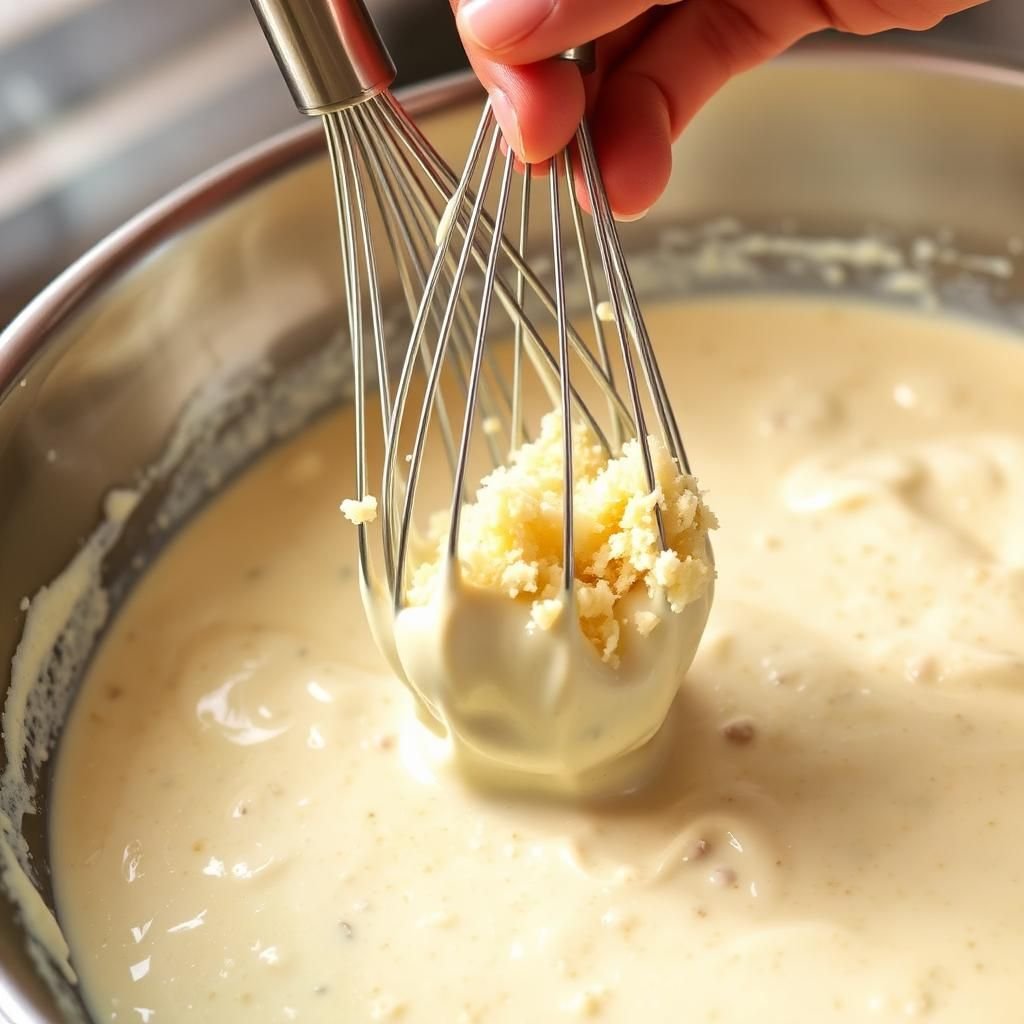
- Build the Flavor Base: Reduce the heat under the skillet where you cooked the chicken to medium-low. Add the remaining 3 tablespoons of unsalted butter to the pan. Scrape up any browned bits (fond) from the bottom of the pan with a wooden spoon or spatula; these are concentrated flavor bombs that will infuse your sauce.
- Sauté Garlic: Add the minced garlic to the melted butter in the skillet. Sauté gently for 30-60 seconds, or until fragrant. Be careful not to burn the garlic, as burnt garlic will turn bitter and ruin your Chicken Alfredo recipe.
- Add Heavy Cream: Pour in the heavy cream. Increase the heat slightly to medium and bring the cream to a gentle simmer, stirring constantly. Let it simmer for 1-2 minutes, allowing it to thicken slightly. Do not bring it to a rolling boil, as this can cause the cream to separate.
- Remove from Heat & Add Cheese: This is a crucial step! Remove the skillet from the heat before adding the Parmigiano-Reggiano. Slowly add the freshly grated cheese to the warm cream mixture, whisking constantly until the cheese is completely melted and the sauce is smooth and velvety. Whisking off the heat prevents the cheese from clumping or becoming stringy.
- Season the Sauce: Season the Alfredo sauce with salt, freshly ground black pepper, and a tiny pinch of freshly grated nutmeg (if using). Taste and adjust seasoning as needed. Remember, the cheese is salty, so add salt incrementally.
Step 4: Combine and Serve Your Masterpiece
- Slice the Chicken: While your sauce is ready, slice the rested chicken breasts against the grain into desired pieces (strips or medallions).
- Toss the Pasta: Add the drained, cooked fettuccine directly into the skillet with the Alfredo sauce. Use tongs to gently toss the pasta, ensuring every strand is thoroughly coated in the creamy sauce.
- Adjust Consistency (with Pasta Water!): If the sauce seems too thick, add a splash (1-2 tablespoons at a time) of the reserved pasta water, continuing to toss until the sauce reaches your desired consistency. The pasta water helps create that perfect cling.
- Incorporate Chicken: You can either add the sliced chicken directly into the skillet with the pasta and sauce and toss gently, or arrange the chicken slices on top of the sauced pasta when serving.
- Serve Immediately: Chicken Alfredo is best served fresh and hot. Garnish with a sprinkle of fresh parsley or extra grated Parmigiano-Reggiano, if desired. Enjoy your truly amazing homemade Chicken Alfredo recipe!
An overhead photo of a bowl of chicken fettucine Alfredo with grated parmesan cheese and parsley on top on a tan stone background
Credit: Photo: Vicky Wasik. Food Styling: Rachel Perlmutter
Pro Tips for Unforgettable Chicken Alfredo
Elevate your Chicken Alfredo recipe from great to truly unforgettable with these expert tips:
- Quality Ingredients Matter Most: This simple dish shines when its components are top-notch. Invest in good quality heavy cream, European-style butter if possible, and especially a block of authentic Parmigiano-Reggiano cheese. These foundational ingredients directly impact the richness and flavor of your Chicken Alfredo.
- Don’t Overcook the Pasta: Cook your fettuccine (or chosen pasta shape) to al dente. Overcooked, mushy pasta won’t hold the sauce well and detracts from the overall texture of your Chicken Alfredo. The pasta will continue to cook slightly when tossed with the hot sauce.
- Freshly Grated Cheese is Non-Negotiable: We cannot stress this enough. Pre-grated cheese contains cellulose, an anti-caking agent that prevents it from melting smoothly. This will result in a grainy, clumpy, or oily sauce instead of the silky, luxurious texture you want for your Chicken Alfredo recipe. Always grate your own cheese from a block.
- Heat Management for the Sauce: When adding the cheese, it’s crucial to remove the skillet from direct heat or lower the heat to very low. High heat can cause the cheese proteins to seize up and become stringy or clumpy. Gentle, residual heat is best for a smooth emulsion. This is a common mistake that can ruin an otherwise perfect Chicken Alfredo recipe.
- The Magic of Pasta Water: Never forget to reserve some pasta water! This starchy liquid is your best friend for adjusting the sauce’s consistency. It helps emulsify the sauce, making it cling beautifully to the pasta, and adds flavor and body. Add it gradually, a tablespoon at a time, until your Chicken Alfredo reaches your desired creaminess.
- Serve Immediately: Alfredo sauce thickens considerably as it cools. For the optimal creamy texture and luscious consistency, serve your Chicken Alfredo piping hot, straight from the skillet to the plate. Have your side dishes ready beforehand!
- Seasoning Layers: Don’t just season the sauce at the end. Season the chicken, salt your pasta water generously, and then season the sauce as you build it. Layering flavors creates a more cohesive and delicious Chicken Alfredo recipe.
- Don’t Overcrowd the Pan (Chicken): When searing the chicken, ensure you don’t overcrowd the skillet. If you add too many pieces, the pan temperature will drop, and the chicken will steam rather than sear, preventing that beautiful golden crust and flavorful fond. Cook in batches if necessary.
Common Mistakes to Avoid When Making Chicken Alfredo
Even with a detailed Chicken Alfredo recipe, certain pitfalls can derail your efforts. Being aware of these common mistakes will help you achieve perfection every time:
- Using Pre-Grated Cheese: As highlighted above, this is the most common culprit for a grainy or separated Alfredo sauce. The anti-caking agents in pre-grated cheese prevent it from melting properly and emulsifying. Always use freshly grated Parmigiano-Reggiano.
- Overcooking the Sauce: Alfredo sauce doesn’t need to simmer for a long time. Overheating or over-reducing the cream can cause it to break or become too thick and cloying. Once the cream gently simmers and the cheese is whisked in, it’s ready.
- Adding Cold Cheese to Hot Sauce: Adding cold, freshly grated cheese directly into a very hot sauce can cause it to seize up and clump. Removing the pan from direct heat or lowering it to very low before whisking in the cheese helps it melt smoothly and integrate properly.
- Not Salting the Pasta Water: Pasta water should be generously salted. It’s your only chance to season the pasta itself. Bland pasta will lead to a bland overall Chicken Alfredo recipe, even with a flavorful sauce.
- Rinsing the Pasta: Never rinse cooked pasta intended for a sauce. The starchy film on the pasta helps the sauce adhere. Rinsing washes away this crucial starch.
- Overcooking the Chicken: Dry, rubbery chicken is a tragedy in any dish. Ensure you don’t overcook your chicken breasts. Pounding them to an even thickness and monitoring their internal temperature (165°F / 74°C) will keep them juicy and tender for your Chicken Alfredo.
- Not Resting the Chicken: Resting the chicken after cooking allows the juices to redistribute throughout the meat, resulting in more tender and succulent pieces. Skipping this step can lead to dry chicken.
- Not Scraping the Fond: Those browned bits left in the pan after searing the chicken are pure flavor. Failing to scrape them up when you add the butter and garlic means you’re leaving a significant flavor boost behind, leading to a less robust Chicken Alfredo recipe.
- Forgetting the Pasta Water: Many recipes emphasize reserving pasta water, and for good reason. It’s the ultimate tool for achieving the perfect sauce consistency and helps everything emulsify beautifully. Don’t skip it!
Variations & Customizations for Your Chicken Alfredo Recipe
While our core Chicken Alfredo recipe is a masterpiece on its own, it’s also wonderfully versatile. Here are ways to customize it to your taste and dietary needs:
Vegetable Additions:
- Broccoli: Steamed or roasted broccoli florets are a classic pairing. Add them to the skillet with the pasta in the final tossing stage.
- Spinach: Fresh spinach wilts beautifully into the warm sauce, adding a touch of green and earthy flavor. Add a few handfuls to the skillet during the final toss.
- Mushrooms: Sautéed sliced mushrooms (cremini or button) in a separate pan until golden brown, then add to the sauce just before the pasta.
- Asparagus: Blanched or roasted asparagus spears add a fresh, slightly bitter contrast.
- Peas: Frozen peas can be added directly to the boiling pasta water during the last minute of cooking, then drained with the pasta.
Other Proteins:
- Shrimp Alfredo: Substitute chicken with shrimp. Sauté the shrimp in the skillet until pink and cooked through, remove, then proceed with the sauce. Add shrimp back in at the end.
- Sausage Alfredo: Brown Italian sausage (sweet or spicy) in the skillet, crumble it, then remove. Proceed with the sauce, and add the cooked sausage back in with the pasta.
- Tofu/Tempeh Alfredo (Vegetarian): For a vegetarian option, press extra-firm tofu or tempeh, cube it, and pan-fry or bake until golden and slightly crispy. Add to the finished sauce.
Spice Variations:
- Spicy Kick: Add a pinch or two of red pepper flakes with the garlic for a subtle warmth.
- Herbal Notes: Fresh herbs like thyme, rosemary, or sage can be very finely minced and added with the garlic for an aromatic twist. A sprinkle of fresh basil or oregano at the end is also lovely.
- Lemon Zest: A tiny amount of fresh lemon zest (avoiding the white pith) can brighten the rich sauce, adding a hint of freshness.
Gluten-Free/Dairy-Free Options:
- Gluten-Free Pasta: Easily adapt this Chicken Alfredo recipe by using your favorite brand of gluten-free pasta. Be mindful of cooking times, as GF pasta can sometimes cook faster.
- Dairy-Free Alfredo: This is more challenging but achievable. Use a high-quality plant-based heavy cream (like cashew cream or oat-based cooking cream), vegan butter, and nutritional yeast or a good quality vegan Parmesan substitute. Note that the texture and flavor will be different from traditional dairy-based Alfredo, but it can still be a delicious alternative.
Storing & Reheating Leftovers: Making Your Chicken Alfredo Last
Alfredo sauce is notoriously tricky for leftovers due to its delicate emulsion. As it cools, the fats can separate, and the sauce can become very thick and clumpy. However, with the right techniques, you can still enjoy your delicious Chicken Alfredo recipe the next day!
Storing:
- Prompt Cooling: As soon as the meal is over, transfer any leftover Chicken Alfredo to an airtight container. Refrigerate promptly within 2 hours. Do not leave it at room temperature for extended periods.
- Separate if Possible: If you anticipate leftovers, sometimes it’s best to store the cooked pasta and chicken separately from the Alfredo sauce. This gives you more control over the sauce’s consistency when reheating. If already combined, that’s fine; just store it together.
- Shelf Life: Leftover Chicken Alfredo is best consumed within 2-3 days when stored properly in the refrigerator. Freezing Alfredo is generally not recommended as the sauce will almost certainly separate and become grainy upon thawing.
Reheating (The Gentle Approach is Key):
The goal is to gently re-emulsify the sauce and warm the ingredients without causing separation or overcooking.
- Stovetop Method (Recommended):
- Transfer your leftover Chicken Alfredo to a large skillet or saucepan.
- Add a splash of liquid. The best option is reserved pasta water if you have it (you can freeze small portions for this purpose!). Alternatively, use heavy cream or a little milk. Start with 1-2 tablespoons per serving.
- Place the skillet over low heat.
- Stir constantly and gently with a wooden spoon or spatula. The sauce will gradually loosen and become creamy again as it warms up.
- Continue stirring and slowly add more liquid, a tablespoon at a time, until the sauce reaches your desired consistency. Be patient and do not rush the process or use high heat.
- Once warmed through and creamy, serve immediately.
- Microwave Method (Use with Caution):
- Place a single serving of Chicken Alfredo in a microwave-safe dish.
- Add a tablespoon or two of heavy cream or milk over the top.
- Heat on 50% power in 30-second intervals, stirring thoroughly after each interval.
- Continue until warmed through and the sauce has re-emulsified. This method is riskier for separation, so low power and frequent stirring are key.
- Avoid: High heat, vigorous boiling, or trying to reheat without adding extra liquid will likely result in an oily, separated, or clumpy sauce.
Pairing Your Chicken Alfredo Pasta
This Chicken Alfredo recipe is rich and satisfying, so complementary side dishes should provide balance and freshness rather than adding more heavy elements.
- Light Salads: A simple green salad with a bright vinaigrette is perfect. The acidity cuts through the richness of the Alfredo sauce, cleansing the palate. Think mixed greens, cherry tomatoes, and a lemon-herb dressing.
- Roasted or Steamed Vegetables:
- Roasted Broccoli or Asparagus: Roasting brings out their natural sweetness and a slight char provides textural contrast. A squeeze of lemon juice after roasting adds freshness.
- Steamed Green Beans: Lightly steamed green beans seasoned with a little garlic and olive oil are a simple, healthy accompaniment.
- Sautéed Zucchini or Spinach: Quick and easy, these vegetables can add a pop of color and freshness.
- Crusty Bread: A warm, crusty baguette or ciabatta is ideal for soaking up any remaining delicious Alfredo sauce. Garlic bread is also a popular choice, though it adds to the richness.
- Wine Pairings:
- White Wines: Opt for medium-bodied, unoaked white wines with good acidity to cut through the creaminess. Examples include a dry Italian Pinot Grigio, a unoaked Chardonnay Chablis, or a Sauvignon Blanc.
- Light-Bodied Red Wines (with caution): If you prefer red, choose a very light-bodied red with low tannins and high acidity. A light Pinot Noir from a cooler climate could work, but it’s generally trickier.
- Sparkling Wine: A dry Prosecco or Cava can also be a surprising and refreshing pairing, offering bubbles that cleanse the palate.
Conclusion: Your Journey to Perfect Chicken Alfredo Begins Now
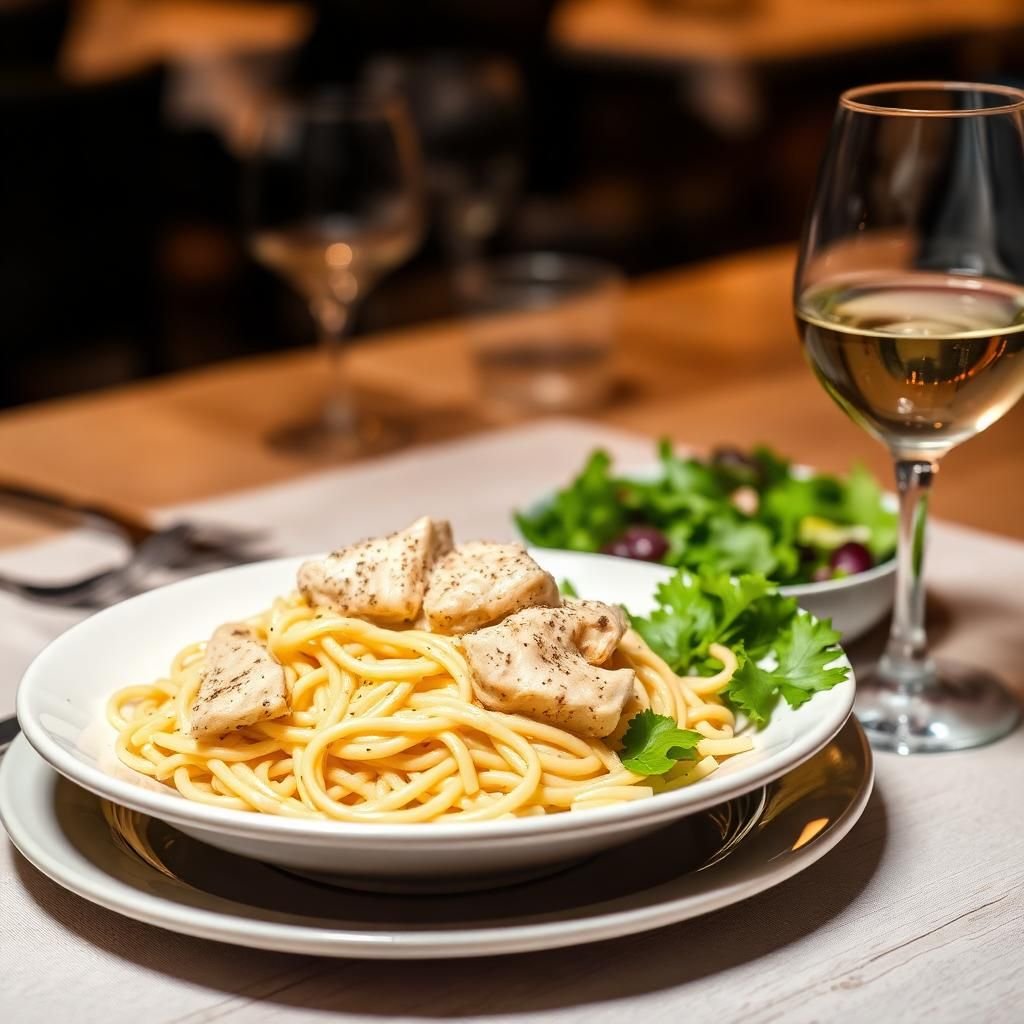
Congratulations! You now have a comprehensive understanding of how to create the ultimate Chicken Alfredo recipe right in your own kitchen. From its fascinating origins to the scientific principles behind its creaminess, and a detailed 4-step process, you are equipped with all the knowledge needed. We’ve covered everything from choosing the best ingredients like freshly grated Parmigiano-Reggiano and quality heavy cream, to mastering the searing of the chicken and the delicate art of emulsifying the sauce with starchy pasta water.
Remember, the magic of this Chicken Alfredo recipe lies in attention to detail: don’t overcook your pasta, always use fresh cheese, manage your heat for the sauce, and never forget that invaluable pasta water. By avoiding common mistakes and embracing these pro tips, you’re not just making a meal; you’re crafting an experience.
This Chicken Alfredo recipe is more than just food; it’s an opportunity to bring comfort, warmth, and a touch of gourmet elegance to your table. It’s a dish that, once mastered, will become a go-to favorite, perfect for weeknight dinners or special occasions. So, gather your ingredients, fire up your stove, and prepare to indulge in the creamy, dreamy perfection of homemade Chicken Alfredo. Your amazing culinary journey starts now. Enjoy every single, flavorful bite!
For more recipes, visit the Recipes category.


![Best Phone in 2025: Don't Buy Wrong! [Tested & Ranked] 8 best-phone-in-2025](https://newiafutures.com/wp-content/uploads/2025/07/best-phone-in-2025-768x580.png)



